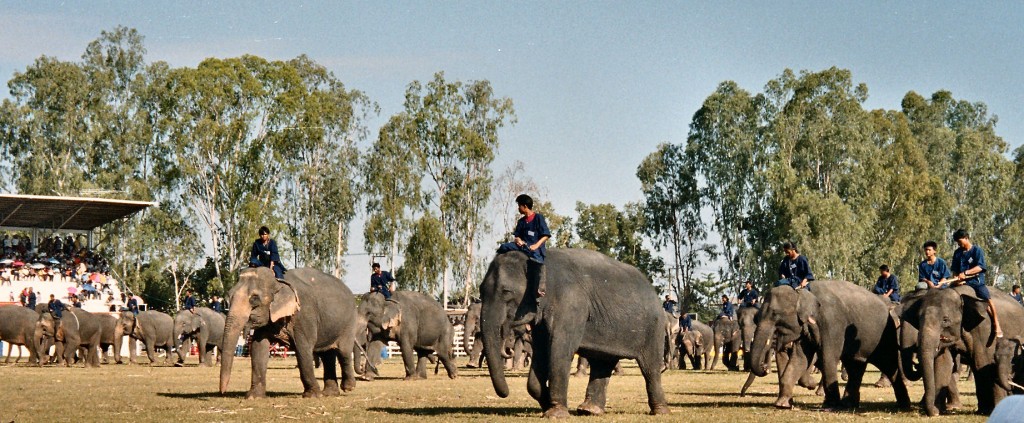Thailand knows how to party. The tropical paradise has become a major recreation destination for both locals and tourists looking for incredible experiences. For a festival to stick out in such a party-packed environment, it must be absolutely incredible. Here are five of the wildest:
- Songkran, or the Thailand Water Festival
Songkran is an annual event marking the traditional Thai New Year, which occurs in April. With festivities centered in Chiang Mai but occurring throughout Thailand, what began as a water-based spiritual cleansing ritual has evolved into what is now known as the largest water fight in the world, with locals armed with super-soaker water guns ready to cheerfully douse passersby.
The water festival origin is about cleaning, purification, and fresh starts. Houses are cleaned, Buddha statues are gently washed with scented water, and elders are honored by pouring water respectfully over their hands. However, April is both Thailand’s hottest month and the end of the dry season, so the joyous, public splashing of water is both symbolic and cooling. Enjoy this wet, rowdy celebration that lasts up to a week, but leave your good shoes at home.
- The Monkey Buffet
It’s all there in the name with this one. The province of Lopburi, north of Bangkok, has been dubbed “Monkey City” for the estimated 3,000 monkeys of the Long-Tailed Macaque variety living alongside the residents. The monkeys can be a bit of a nuisance, but they are generally tolerated and even well-regarded by some because of an ancient Sanskrit tale telling of a heroic monkey of that breed in that region.
The monkeys also bring in tourists, which is why the Lopburi Monkey Buffet Festival was created. In 1989, a hotelier created the event to bring in money-spending tourists. With the backing of the Tourism Authority of Thailand, he organized the lavish vegetarian buffet to be served among the ruins of the Khmer temple of Pra Prang Sam Yot, where the majority of the monkeys live.
Every November since, tourists have flocked to experience the comical sight of monkeys being given gilded invitations to their buffet and being served a five-star spread of enormous amounts of food, and behaving like, well, monkeys.
- Bun Bang Fai Rocket Festival
Get ready to rock(et)! Dating back to pre-Buddhist times, Bun Bang Fai is held around the May full moon, and is based on the notion that launching bamboo rockets skyward will initiate the rainy season and bring much needed water to the country’s rice fields. Traditionally, crude “rockets” were constructed out of bamboo and stuffed with gunpowder, but today, many different materials are used, including PVC or metal piping. These rockets are made in a variety of sizes, starting from foot-long bottle rockets to an impressive (and potentially quite dangerous) nine meters in length. Some of the biggest rockets are packed with up to 120 kg of gunpowder and balanced precariously on a launching tower made of bamboo scaffolding.
Injuries are not uncommon, but the goal is to score points: The event is judged by a panel of individuals who assess the rockets based on height and distance traveled, as well as spectacular vapor trails. For those unsuccessful team members whose rockets fail to launch or fall shortly after launch, the tradition is to dump them into a nearby pool of mud.
- Surin Elephant Festival
Back during medieval times, Thailand’s Surin province was home to ritualistic elephant hunts, in which the majestic animals were rounded up, corralled and captured in hunts that incorporated many mythological aspects and intentions. These hunts also served an economic purpose, as the captured elephants were domesticated and used as pack animals and war animals.
Throughout the centuries, the hunts were converted more and more each year into a public spectacle and lost much of their ritualistic element, ultimately being abandoned in the mid-20th century. A few decades later, it was revived as a fully-staged tourist attraction, retaining none of its original intent.
Travelers come from far and wide each November to observe a parade of hundreds of elephants, in what Lonely Planet calls “an unforgettable sight.” There is then an “elephant breakfast,” not unlike the monkey buffet, followed by elephant talent competitions, demonstrations of the various techniques used to capture and train elephants, and a presentation of ancient elephant warfare techniques. There are presentations displaying the strength and skill of the animals, such as football games, a tug-of-war between men and elephants, and even elephants painting and dancing.
- Phi Ta Khon
Phi Ta Khon, also known as the Ghost Festival, occurs over three days on the first weekend after the 6th full moon of the year in the Dan Sai, Loei province. The origins of this part of the festival are traditionally attributed to a story of the Vessantara Jataka in which the Buddha is a prince in one of his past lives who made a long journey and was presumed dead. The celebrations on his return were so raucous as to wake the dead.
During the Ghost Festival, the town’s residents invite protection from Phra U-Pakut, the spirit of the Mun River. They then hold a series of games and take part in a procession wearing elaborate masks and wild costumes including bells and wooden phalluses.
Phi Ta Khon incorporates rockets, costume and dance contests, parades, and sermons from Buddhist monks.
